Process Flow Chart of Garments Export Process
Garments Export Process:
Garments export process means all the processes required from order receiving to shipment. Every garments merchandiser plays an important role in completing the garments export orders. It’s not an easy task that we have normally seemed. Garments merchandiser has to sacrifice a lot of matter to earn profit from an export order. To perform all the required functions for the export order, the garments merchandiser should follow a process flow chart which will help him to do the right task at the right time. This article has shown all the required matters for completing the garments export processes.

Process Sequence of Garments Export Process:
Contact with the buyer
↓
Order collection
↓
Sample development
↓
Sample approval
↓
Costing
↓
Confirmation of order
↓
Consumption
↓
Fabric & accessories booking
↓
Master L/C
↓
Back to back L/C
↓
Preparing T&A calendar
↓
Fabric & trims in House
↓
Pre-production meeting
↓
Pattern and marker making for bulk production
↓
Cutting
↓
Numbering, bundling & sorting
↓
Production line set-up
↓
Sewing
↓
Finishing
↓
Pre-final inspection
↓
Final inspection
↓
Ready for shipment
All the above processes have discussed in the below table:
|
SL
No. |
Process
|
Procedure
|
|
01
|
Contact with the buyer
|
It is the first process of a garment export order. At first, the garments merchandiser has to contact the buyer for order collection.
|
|
02
|
Order collection
|
Here garments merchandiser receives garments orders from the buyer. Each order contains a garments specification sheet for different items or products.
|
|
03
|
Sample development
|
After receiving an export order, the garments merchandiser has to develop the required products by following the garments specification sheet.
|
|
04
|
Sample approval
|
After developing the product sample, the garments merchandiser sends it to the buyer for approval.
|
|
05
|
Costing
|
If the product sample is approved then the garments merchandiser will make the final costing for the product by discussing with the buyer.
|
|
06
|
Confirmation of order
|
Finally, the garments merchandiser confirms the order here.
|
|
07
|
Consumption
|
After confirmation of a garment export order, garments
merchandiser has to prepare the consumption of required fabrics, trimmings, and accessories. |
|
08
|
Fabric & accessories booking
|
Here, fabrics and accessories booking has been done to in-house the required items for the export order.
|
|
09
|
Master L/C
|
Meanwhile, master L/C is opened from the buyer side and submitted to the garments merchandiser.
|
|
10
|
Back to back L/C
|
For importing raw materials for the export order, here manufacturer has to open back to back L/C.
|
|
11
|
Preparing T&A calendar
|
In the meantime, the garments merchandiser has o prepare a time and action plan here for the garments production.
|
|
12
|
Fabric & trims in house
|
All the required fabrics, trimmings and accessories are in-housed here according to the booking chart.
|
|
13
|
Pre-production meeting
|
It’s an important factor for garments production. The production team should complete this meeting before starting the production.
|
|
14
|
Pattern and marker making for bulk clothing production
|
Here, the pattern and marker should prepare according to the approved sample.
|
|
15
|
Cutting
|
Fabrics cutting are done here according to the approved
pattern and marker. |
|
16
|
Numbering, bundling & sorting
|
Here all the cutting fabrics have to do numbering sorting and bundling to avoid shade variation in the garments.
|
|
17
|
Production line set-up
|
Here, the production team sets a perfect production line for
completing smooth garments production. |
|
18
|
Sewing
|
All the cutting fabrics are sewn here according to the approved sample.
|
|
19
|
Finishing
|
All the required finishing procedures are done here by
following the buyer’s instruction. |
|
20
|
Pre-final inspection
|
Here, a pre-final inspection has been done to ensure the right quality for the export order. Normally it is done by the factory inspection team.
|
|
21
|
Final inspection
|
Final inspection of an order has been done here by the buyer’s inspection team. Where the inspection team is confirmed by the buyer.
|
|
22
|
Ready for shipment
|
Finally, garments are sent to the buyer by using sea freight or air freight.
|

Mayedul Islam is a Founder and Editor of Garments Merchandising. He is an Expert in Garments Merchandising. Writing is his passion. He loves to write articles about Apparel, Textile and Garment Washing specially on Merchandising. Mail him at mayedul.islam66@gmail.com


Very Nice information
My job is a garnent merchandise.also work for a home texitile company.I need your help
sir i am working in leather garments factory and i search leather garment buyer last 2 years but no response so please help us for how to search buyer.
I’m doing merchandise course in a privet institution.
they can’t teach me the proper things.
all I learned about merchandising.. I got from this website .
thanks a lot https://garmentsmerchandising.com
you are my teacher.
Stay with us for more.
Bangladesh is improving day by day in RMG sector. Many investment is on this sector. Factories are investing on robotics and new machines. The modern equipment will increase the production and also improve the factory environment